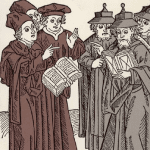On This Day in Jewish History: June 20, 1510
On this day in Jewish history, 20 June 1510, converso Jewish legend and philanthropist Doña Gracia Nasi was born. Doña Gracia Nasi was a woman of many names, overseer of a business empire that rivaled the grand kingdoms of Christendom, she struck her defiance against the Pope and was perhaps the chief architect of the later Zionist movement. On this day in Jewish history, 20 June, in 1510, an epic that encompasses the Mediterranean began with the birth of Doña Gracia Nasi.
She was born Beatrice de Luna in Lisbon, Portugal to a family of Converso-Jews who had escaped the Inquisition in Spain. Iberia had been home to Jews for hundreds, if not thousands of years as reports range from the Pax Romana to the rule of the Visigoths. In 711, the Umayyad Caliphate, the second Islamic empire after the death of Muhammed, invaded Hispania leading to Islamic rule over the peninsula for the better part of the next century. While life for Jews in the Kingdom of Al-Andalus (the Arabic name for Iberia) was not equitable, conditions were favorable compared to the earlier and future Christian hegemony. This was a period that could not be defined solely as hostility nor harmony but as a time of pluralist collaboration and growth in knowledge that is seen as a Sephardic golden age.
However, Christian fervor in the remaining Christian bastion in northern Iberia steadily grew resulting in the enactment of the Reconquista – at first the slow expansion of Christian Kingdoms in Iberia which morphed into a pseudo-crusade to insert Catholic dominance across the peninsula. By the 15th century, Iberia would be conquered and dominated by the Christian Kingdoms of Portugal, Castile, and Aragon. The latter two would be joined in a personal union in 1479 with the marriage of Queen Isabella of Castile and King Ferdinand II of Aragon.
Under this united monarchy, the Jews of Spain were expelled, many fleeing to neighboring Portugal. Of these refugees were the Nasi family who left behind hundreds of years of history. In Portugal, they had to convert or face death. Thus, they became the de Luna family, however, in private they would still observe the Sabbath, attempt to keep kosher and celebrate holidays such as Pesach. While the de Luna family would nominally be known as New Christian, to the larger Iberian world they would be Marranos (Swine in Spanish) showing how they were still a discriminated cast.
Not much is known about Beatrice de Luna’s childhood except for her beauty and intellect. At eighteen, she married a fellow converso, New Christian, Francisco Mendes – a merchant who had grown his wealth in the spice trade of the East Indies.
Mendes’s brother and business partner, Diogo, had set up trade in the Spanish-ruled Antwerp (modern-day Belgium) obtaining a monopoly over the Portuguese spice market. Antwerp was the centre of European commerce at the time, yet this did not protect the trader from the Spanish Inquisition. Only under the expressed protection of King João III of Portugal to his brother-in-law, Emperor Charles X of Spain, and the Holy Roman Empire, were the charges against Diego dropped. Beatrice’s life would change forever in 1536. After eight years of marriage and a daughter, Ana, Francisco passed away. In his will, Mendes left half his fortune to his wife while the other would go to Diogo in Antwerp. That same year, the widow fled to her brother-in-law as the Pope established an Inquisition in Portugal with many similarities to that found in the rest of the peninsula. While still under Spanish rule, the family knew they were not safe yet. Once settled, Diogo and Beatrice built an underground railroad to help other conversos escape from Portugal. They prepared them for their long journeys and even helped transfer their assets. Diego married Beatrice’s sister, Brianda, further cementing the families’ ties. This relationship would mirror Naci and Francisco’s tragic marriage, as Diogo died in 1543 leaving Brianda, like her sister, widowed and raising a daughter, Beatrice – after her aunt. Diogo left the Mendes properties and the administration of his estate and fortune to Beatrice (Doña Gracia), resulting in a rift between the two sisters.
Meanwhile, tensions between the family and Emperor Charles X rose. Increased skepticism of Francisco’s true religious beliefs and the emperor’s endorsement of a marriage between his protégé and the ten-year-old Ana. The prime motivation being the theft of the Mendes fortune. There was also an inquiry into the large influx of Portuguese conversos to Antwerp.
From all these factors it is easy to understand why Beatrice, Ana, Brianda and the younger Beatrice would make their escape to Venice leaving behind her nephew João Micas (later to change his name to Joseph Nasi) to manage the remaining dealing in their Flemish home. The floating city had a large Jewish population for the time, though they had been bound to a ghetto that was sealed at night. The sisters still wore their Christian façade allowing them to live a bourgeois lifestyle on the Grand Canal. However, behind closed doors, they would continue to practice Judaism. The sisters faced off in legal battles in the Venetian courts over the younger Beatrice’s inheritance. Beatrice began to move her assets over to Constantinople (present-day Istanbul), the capital of the Ottoman Empire. The Venetians likely expected her to flee across the Adriatic and quickly intervened in the quelling sisters’ troubles. The Venetians hoped to maintain the Mendes fortune within their domain. They ruled that the money owed to the younger Beatrice be managed by the mint.
However, Beatrice had other plans. She had contacted Duke Ercole II to move her assets and family to Ferrara. While in the proximity of the Papal States, the Duke was pleased to receive the influx in wealth, and thus agreed to side with Beatrice by accepting Diogo’s original will. Soon her sister would begrudgingly join her. Ferrara was accepting of Jews. Many Jews, including the Mendez sisters, would openly practice their Judaism. Beatrice would take on the name Doña Gracia Nasi while her daughter would become Reyna. She would continue her network to help smuggle other conversos out of Iberia to Ferrara and the Ottoman Empire. She even supported the expanding printing industry, where Spanish versions of the Talmud were printed. One version was marketed to Christian scholars while the other, dedicated to her, was created for Jews. Her contribution to the arts eased many converso’s integration into Ferrara. Evidently, peaceful times in Ferrara would not last long. After an outbreak of the Bubonic Plague, the duke involuntarily expelled the city’s Jewish population to placate the Ferraresi population. Although he later invited them back. The sisters returned to Venice where Doña Gracia was arrested, and their legal disputes resumed. Their disputes would finally conclude with one hundred thousand ducats being left to Beatriz until she reached fifteen and Briana would receive fifteen thousand ducats with an added sustentation of fifteen hundred ducats per annum henceforth.
After years of planning, Doña Gracia and Reyna made their voyage towards Constantinople. In 1553, she arrived in Constantinople, the city that exactly one hundred years before fell from Byzantine to Ottoman hands. While she chose to live in the affluent Galata quarter, she became a staple of Jewish life in the city. At the time, the Ottoman Empire had been accepting of Jews. During the initial inquisition, Sultan Bayezid II had claimed, “he who impoverishes his country and enriches our own!” as many Sephardim began to flee Eastward.
Doña Gracia became a central figure in Jewish life in the Ottoman capital. Her network to smuggle Sephardic refugees continued. She spent a generous sum of ducats supporting rabbinic scholars and synagogues across the empire, but within the capital, she would finance the creation of a new synagogue and yeshiva. When more conversos arrived in Constantinople she financed a second synagogue to support the growing community. Her charity reached across the Mediterranean as she aimed to free those captives and in distress elsewhere.
Moreover, her actions were not restricted to financial support. In 1556, Doña Gracia would face her greatest rival yet – Pope Paul IV. For the proceeding two decades, the town of Ancona had been largely accepting of Jewish immigration from Iberia. While the town was under Papal control, the Pope granted the Jewish population of Ancona protection in hopes of inspiring trade between the Ottomans and the Papacy.
Pope Paul IV was an antisemite proven when he issued the “Cum nimis absurdum” bull which restricted the Jews of Rome to a ghetto and forced them to endure other humiliations. Unsurprisingly, in 1556, he revoked the papacy’s protection in Ancona by arresting Jewish worshippers and sending twenty-four to the stake. Enraged by this, Doña Gracia mobilized quickly to show her disproval. In her time in Constantinople, she had become close to the current caliph, Sultan Suleiman the Magnificent. She used her political leverage to request Suleiman intervene against the Papal ruler. Suleiman agreed, issuing an ultimatum demanding the release of Ottoman subjects and property. While the Ottomans would seize Anconitani ships around his empire.
The Pope relented and released the Ottoman subjects, he continued to persecute the other Jews of the city. Suleiman was unable to aid further as he was already involved in another war with Christendom. Doña Gracia was determined not to abandon the Jews of Ancona. She organized a Jewish boycott of the city. While the boycott saw early success with many Christian bankruptcies in the city and a deficit of Ottoman merchandise, soon trade increased again. Many felt the boycott only hurt the Jews in Ancona more while others saw a financial gain. She never gave up her vendetta. Her merchandise would never stop in Ancona after that. She relentlessly wrote to the rabbis across the empire to remind them of the Ancona anguish.
Nearly a decade later, using her goodwill with Suleiman, she obtained a lease to build a Jewish settlement in the holy city of Tiberias in the Galilee. Her nephew, Joseph Nasi, who also became close to the Ottoman Sultan, oversaw the construction of the new Jewish settlement that would serve as a haven for Sephardim fleeing areas under Iberian control. Doña Gracia financed the project and ordered a villa to be constructed for her. She never got to see her vision as her waning health stopped her from ever leaving Constantinople.
While a community did form in Tiberias, it barely lasted a generation. Her ideas were ahead of her time. She passed away in 1569. She will be remembered for her intelligence, beauty, and charity but amongst it all was her love for the Jewish people. A true mother to the Jewish People and Israel. Upon her request, she was buried beside her husband in the holy land. May her memory be a blessing.
References:
Context: Nogueiro, I., Teixeira, J., Amorim, A., Gusṃo, L. and Alvarez, L., 2015. Portuguese crypto-Jews: the genetic heritage of a complex history. Frontiers in Genetics, [online] 6. Available at: [Accessed 13 June 2022]. Newworldencyclopedia.org. 2009. Umayyad conquest of Hispania РNew World Encyclopedia. [online] Available at:
title=Umayyad_conquest_of_Hispania&oldid=935495> [Accessed 13 June 2022]. Doña Gracia Nasi specifically: Bodian, M., 1999. Doña Gracia Nasi | Jewish Women’s Archive. [online] Jewish Women’s Archive. Available at: [Accessed 13 June 2022]. Green, D., 2013. This Day in Jewish History | 1555: Pope Paul IV Orders Jews to Live in a Ghetto. haaretz, [online] Available at: [Accessed 16 June 2022] . Encyclopedia.com. 2022. Nasi, Gracia Mendes (1510–1569) | Encyclopedia.com. [online] Available at: [Accessed 14 June 2022]. Salomon, H. and di Leone Leoni, A., 1998. Mendes, Benveniste, de Luna, Micas, Nasci: The State of the Art (1532-1558). The Jewish Quarterly Review, [online] 88(3/4), p.135.
Available at: [Accessed 15 June 2022]. Taitz, E., n.d. Doña Gracia Nasi | My Jewish Learning. [online] My Jewish Learning. Available at: /article/dona-gracia-nasi/> [Accessed 13 June 2022].













Start the discussion at community.jewishoriginal.com